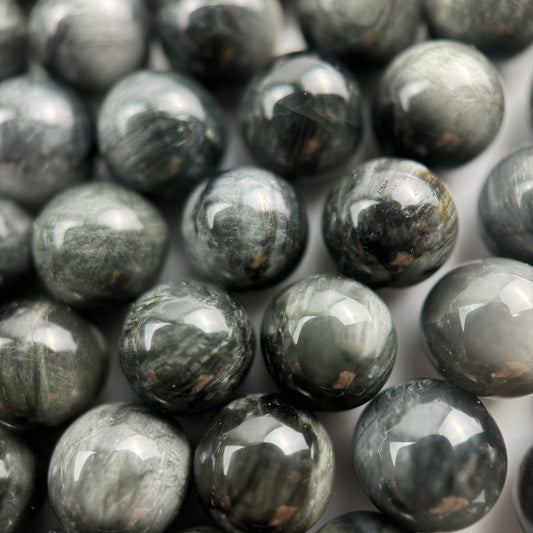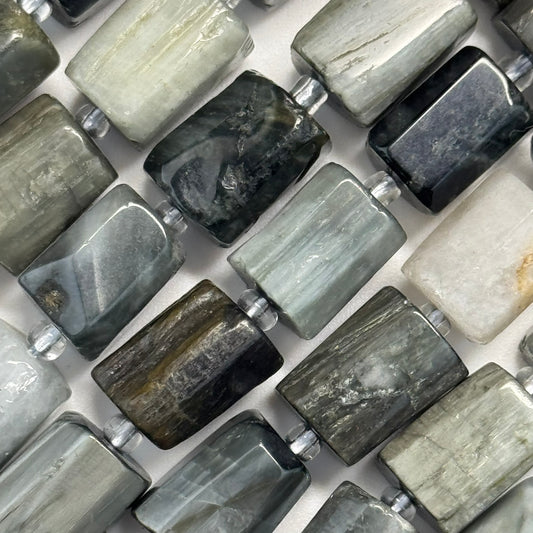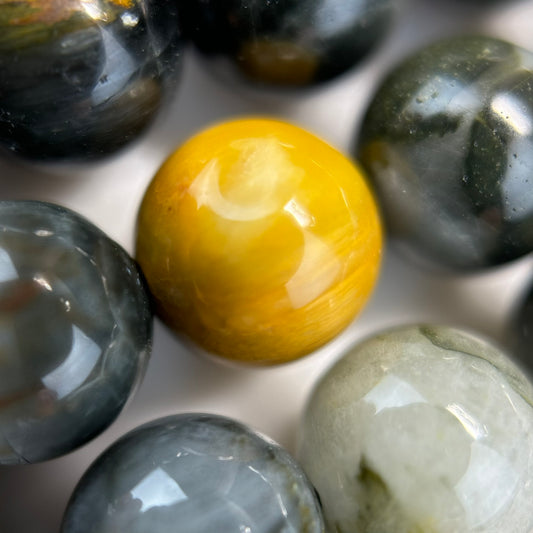Hawk's Eye Gemstone Beads
Introduction to Hawk's Eye Gemstone Beads
Hawk's Eye is a captivating variety of quartz distinguished by its blue-gray color and remarkable chatoyancy, creating a silky, moving light effect reminiscent of a hawk's piercing gaze. This gemstone forms through the pseudomorphosis of crocidolite asbestos fibers, where silica gradually replaces the original mineral while preserving its fibrous structure.
Key Characteristics
- Blue-gray to blue-green coloration
- Distinctive chatoyant effect (cat's eye)
- Silky luster from parallel fibrous inclusions
- Mohs hardness of 7 for durability
- Translucent to opaque appearance
Mineralogical Composition and Structure
Hawk's Eye consists primarily of silicon dioxide (SiO2) with preserved crocidolite fibers that create its characteristic optical properties. The stone represents a complete pseudomorph, where the original crocidolite structure remains intact despite chemical replacement.
Chemical Properties
- Primary composition: Silicon dioxide (SiO2)
- Original mineral: Crocidolite asbestos (sodium iron silicate)
- Replacement process: Silicification preserving fibrous structure
- Crystal system: Trigonal (quartz structure)
- Specific gravity: 2.64 to 2.71
Formation and Geological Origins
Hawk's Eye forms in metamorphic environments where crocidolite-bearing rocks undergo silicification. This process occurs over millions of years as silica-rich solutions percolate through rock formations, gradually replacing the original mineral while maintaining its structure.
Geological Conditions
- Metamorphic rock environments
- Hydrothermal activity with silica-rich solutions
- Temperature range: 200-400°C
- Pressure conditions: Moderate to high
- Time scale: Millions of years for complete replacement
Optical Properties and Chatoyancy
The most distinctive feature of Hawk's Eye is its chatoyancy, a silky, moving light effect that appears as a bright band of light across the stone's surface. This phenomenon results from parallel fibrous inclusions reflecting light in a specific direction.
Chatoyancy Mechanics
- Parallel fibrous inclusions create light reflection
- Single bright band moves across surface when rotated
- Best observed under direct light sources
- Effect enhanced by cabochon cutting
- Orientation critical for maximum effect
Color Variations and Grading
Hawk's Eye displays a range of blue-gray tones, from pale silvery-blue to deep steel-blue. Color intensity and uniformity affect the stone's value and visual appeal.
Color Characteristics
- Primary colors: Blue-gray, steel-blue, blue-green
- Color intensity varies with fiber density
- Uniform coloration preferred for jewelry
- Some specimens show color zoning
- Natural variations add character
Cutting and Lapidary Techniques
Proper cutting is essential to maximize Hawk's Eye chatoyancy. The stone must be oriented so the fibrous structure runs perpendicular to the base, creating the optimal light reflection effect.
Cutting Considerations
- Cabochon cut maximizes chatoyancy
- Oval and round shapes most common
- Fiber orientation critical for effect
- High dome enhances light reflection
- Polished surface reveals silky luster
Hardness and Durability
With a Mohs hardness of 7, Hawk's Eye offers good durability for jewelry applications. However, its fibrous structure requires careful handling to prevent damage along cleavage directions.
Durability Factors
- Mohs hardness: 7 (good for jewelry)
- No distinct cleavage planes
- Conchoidal fracture pattern
- Resistant to scratching from most materials
- Stable under normal conditions
Sources and Geographic Distribution
Hawk's Eye occurs in several locations worldwide, with notable deposits in South Africa, Australia, India, and Brazil. Each source may produce stones with slightly different characteristics.
Primary Sources
- South Africa: High-quality blue-gray material
- Australia: Various shades including greenish tones
- India: Traditional source with good chatoyancy
- Brazil: Commercial quantities available
- Myanmar: Smaller but quality deposits
Care and Maintenance Guidelines
Proper care ensures Hawk's Eye maintains its beauty and chatoyant effect. While relatively durable, the stone benefits from appropriate cleaning and storage practices.
Care Instructions
- Clean with warm soapy water and soft brush
- Dry thoroughly with soft cloth
- Store separately to prevent scratching
- Avoid ultrasonic cleaners
- Protect from harsh chemicals
- Occasional polishing restores luster
Jewelry Design Applications
Hawk's Eye beads create striking jewelry pieces, particularly when the chatoyant effect is showcased. The stone's neutral blue-gray color complements various metal settings and other gemstones.
Design Ideas
- Strand necklaces highlighting chatoyancy
- Bracelets with uniform bead sizes
- Earrings featuring single chatoyant beads
- Combinations with complementary stones
- Men's jewelry applications
- Contemporary and traditional styles
Metaphysical Properties and Symbolism
Hawk's Eye holds significance in various metaphysical traditions, associated with vision, clarity, and protection. These associations enhance its appeal beyond physical beauty.
Symbolic Meanings
- Vision and clarity of thought
- Protection from negative energy
- Enhanced intuition and perception
- Connection to higher awareness
- Focus and concentration
Comparison with Related Stones
Hawk's Eye belongs to the quartz family alongside Tiger's Eye and other chatoyant varieties. Understanding these relationships helps in identification and appreciation.
Related Varieties
- Tiger's Eye: Golden-brown with similar chatoyancy
- Bull's Eye: Reddish-brown oxidized form
- Falcon's Eye: Greenish variety
- Blue Tiger's Eye: Trade name for Hawk's Eye
- All share similar fibrous structure
Frequently Asked Questions
What is the mineral composition of Hawk's Eye gemstone beads?
Hawk's Eye is a variety of quartz (SiO2) that contains parallel fibers of crocidolite asbestos, which have been replaced by silica through pseudomorphosis. The blue-gray color comes from the preserved fibrous structure of the original crocidolite.
What is the Mohs hardness rating of Hawk's Eye beads?
Hawk's Eye has a Mohs hardness of 7, making it durable enough for everyday jewelry wear. This hardness rating means it can resist scratches from most common materials but should be protected from harder gemstones like diamond, corundum, and topaz.
What causes the chatoyancy (cat's eye effect) in Hawk's Eye beads?
The chatoyancy in Hawk's Eye is caused by the parallel alignment of microscopic fibrous inclusions within the quartz matrix. When light strikes these parallel fibers at the correct angle, it creates a silky, moving light band that resembles a cat's eye or hawk's eye.
What is the difference between Hawk's Eye and Tiger's Eye gemstones?
Hawk's Eye is the blue-gray variety of quartz with crocidolite inclusions, while Tiger's Eye is the golden-brown variety where the crocidolite has been oxidized. Both share the same fibrous structure but differ in color due to the oxidation state of iron within the inclusions.
What are the primary geological sources of Hawk's Eye gemstone?
Hawk's Eye is primarily sourced from South Africa, particularly the Northern Cape Province. Other significant deposits are found in Western Australia, India, Myanmar, and Brazil. The South African material is considered the finest quality.
How does the fibrous structure affect the cutting and drilling of Hawk's Eye beads?
The parallel fibrous structure of Hawk's Eye requires careful orientation during cutting to maximize the chatoyant effect. Beads should be cut perpendicular to the fiber direction to display the optimal cat's eye band. Drilling must be done carefully to avoid fracturing along the fiber planes.
What is the specific gravity and refractive index of Hawk's Eye?
Hawk's Eye has a specific gravity ranging from 2.64 to 2.71, and a refractive index of approximately 1.544-1.553. These optical properties help gemologists identify and distinguish Hawk's Eye from other similar-looking gemstones.
Can Hawk's Eye beads be heat treated or enhanced?
Hawk's Eye is typically not heat treated, as high temperatures can damage the fibrous structure that creates its characteristic chatoyancy. However, some material may be dyed to enhance color, though natural blue-gray specimens are most valued.
What causes the color variations in Hawk's Eye gemstone beads?
Color variations in Hawk's Eye result from differences in the iron content and oxidation state of the crocidolite inclusions, as well as the density and alignment of the fibrous structures. Some specimens may show greenish or bluish tints depending on these factors.
How should Hawk's Eye beads be stored to prevent damage?
Store Hawk's Eye beads separately from harder gemstones to prevent scratching. Avoid exposure to extreme temperatures, as thermal shock can cause fracturing along the fiber planes. Keep them in a soft pouch or lined jewelry box away from direct sunlight.
What is the crystal system and cleavage of Hawk's Eye?
Hawk's Eye belongs to the trigonal crystal system (like all quartz varieties) but typically forms in massive, fibrous aggregates rather than distinct crystals. It has no true cleavage but may exhibit conchoidal fracture, with a tendency to break along fiber planes.
How does the quality of Hawk's Eye beads affect their value?
High-quality Hawk's Eye beads feature a sharp, well-defined chatoyant band that moves smoothly across the surface, uniform color distribution, good translucency, and minimal inclusions or fractures. The intensity and clarity of the cat's eye effect significantly impact value.
What are the optical properties that make Hawk's Eye suitable for jewelry?
Hawk's Eye's combination of good hardness (7 on Mohs scale), attractive chatoyancy, durability, and unique visual appeal make it excellent for jewelry. The silky luster and moving light band create an eye-catching effect that works well in both casual and formal designs.
How can you identify genuine Hawk's Eye beads from imitations?
Genuine Hawk's Eye will show a distinct chatoyant band that moves when the bead is rotated, have a specific gravity around 2.65-2.71, and display the characteristic blue-gray color with fibrous structure visible under magnification. Synthetic materials lack the natural fibrous inclusions.
What is the relationship between Hawk's Eye and the quartz family?
Hawk's Eye is a cryptocrystalline variety of quartz, meaning its crystal structure is so fine-grained that individual crystals cannot be distinguished. It's part of the quartz family alongside agate, jasper, and chalcedony, sharing the same chemical composition (SiO2) but with unique structural characteristics.





